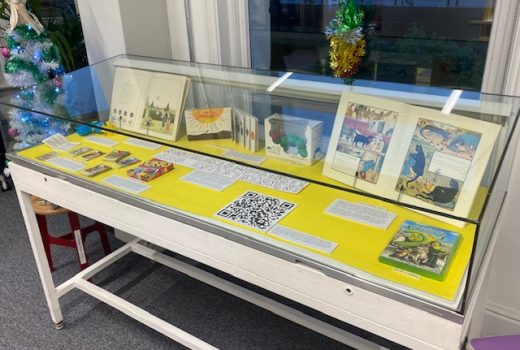BA Art History and Visual Culture and BA Fashion and Dress History students Vasilii Bruni, Albert Holloway, Niamh Carden, Olivia Ratcliffe and Camille Scribner announce their new exhibition, now on display at Pavilion Parade at the University of Brighton
From Disney to ‘Disneyfication’ is an exhibition curated to highlight how Disney established a multi-media monopoly, from its humble beginnings in the 1920s to the global franchise it is today. It considers the impact of ‘Disneyfication’ on materials from theme parks brochures to Mickey Mouse illustrations.
Disney as a franchise is at the forefront of rapid Western globalisation, a huge part of twentieth-century media consumption. It has been catapulted into an advertisement empire by the consumerist lifestyle of the 21st century. Our aim with this exhibition is to illustrate the narrative of Disney as a company and its undeniable influence on the Western mass market.
The term ‘Disneyfication’ comes from the field of sociology, meaning:
“the homogenization of entertainment into something simplified, controlled and “safe” – reminiscent of the Walt Disney Brand.”
The exhibition includes artefacts produced pre-Disneyfication and post-Disneyfication, including a Mickey Mouse annual from the 1930s and a Snow White and the Seven Dwarfs-inspired dental hygiene advertisement to encompass the commercialisation and distribution of entertainment through different media.
The exhibit also aims to highlight the sanitisation of mainstream media, championed by mega corporations. It features artefacts from the Marvel and Star Wars franchises showcasing their previous merchandise before their standardised “safer” format that is recognisable as being a product of the Walt Disney Company.
Although we want to call attention to the monopoly Disney has on mega media franchises, we also want to celebrate the universal affiliation with its well-known fictional characters and universes. Disney has been a household name for generations, so we chose items that were recognisable and familiar to all, from casual fans to cult followers. We wanted to ensure that all visitors will have at least one memory they can fondly recall when looking at our display.
“Since my childhood, Disney has always been a factor in the media I consume, like the movies I would watch and the books I would’ve read. It is an integral part of lots of people’s childhoods and even going into many of our adult lives, especially now as they branch out and own media such as Star Wars, which is something that I still watch and enjoy. It’s interesting to see how it has changed and developed to appeal to a wider audience and this is why I think it’s a highly interesting topic to base our exhibition upon”, Olivia Ratcliffe, Group Researcher
Starting the 13th of December 2022 students and staff of the University of Brighton will be able to visit the exhibition at the Pavilion Parade building located in the City Campus.












